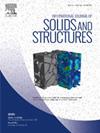Buckling of plane frames under unilateral kinematic constraints
IF 3.4
3区 工程技术
Q1 MECHANICS
International Journal of Solids and Structures
Pub Date : 2024-12-07
DOI:10.1016/j.ijsolstr.2024.113185
引用次数: 0
Abstract
This work deals with the buckling of elastic frames in the presence of supports that restrict motion (either translational or rotational) in one direction only: the so called “unilateral supports”. A new method is presented for computing the bifurcation loads and modes of kinematically constrained, slender reticulated structures, using a single finite element per bar for stability analysis. One considers exact finite elements of axially loaded bars that may be either (a) compressed, (b) with no axial force or (c) tensioned. The numerical computation of bifurcation loads and buckling modes is based on a doubly nonlinear eigenvalue problem: (i) nonlinear because the load parameter appears scattered in the several stability functions (that are circular trigonometric or hyperbolic trigonometric, respectively for compression or tension) and (ii) nonlinear due to the complementarity conditions corresponding to the unilateral support conditions. The new method, which uses a single element per bar, is validated by comparing cases with and without unilateral supports to numerical and analytical results from the literature.
求助全文
约1分钟内获得全文
求助全文
来源期刊
CiteScore
6.70
自引率
8.30%
发文量
405
审稿时长
70 days
期刊介绍:
The International Journal of Solids and Structures has as its objective the publication and dissemination of original research in Mechanics of Solids and Structures as a field of Applied Science and Engineering. It fosters thus the exchange of ideas among workers in different parts of the world and also among workers who emphasize different aspects of the foundations and applications of the field.
Standing as it does at the cross-roads of Materials Science, Life Sciences, Mathematics, Physics and Engineering Design, the Mechanics of Solids and Structures is experiencing considerable growth as a result of recent technological advances. The Journal, by providing an international medium of communication, is encouraging this growth and is encompassing all aspects of the field from the more classical problems of structural analysis to mechanics of solids continually interacting with other media and including fracture, flow, wave propagation, heat transfer, thermal effects in solids, optimum design methods, model analysis, structural topology and numerical techniques. Interest extends to both inorganic and organic solids and structures.

 求助内容:
求助内容: 应助结果提醒方式:
应助结果提醒方式:


